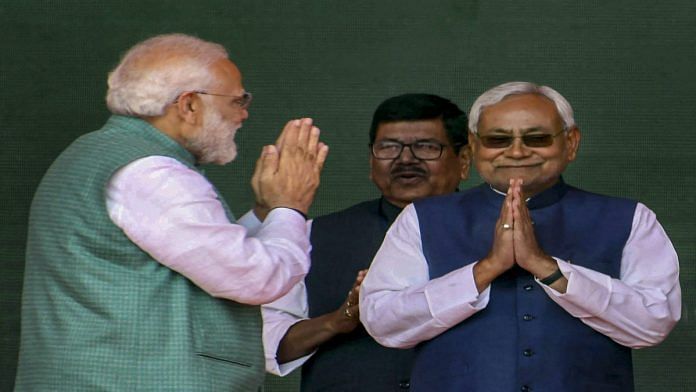The Bhartiya Janata Party is sitting on an OBC quota landmine, which may erupt just before the Bihar assembly election. The Ministry of Social Justice and Empowerment of the Narendra Modi government has prepared a note that could potentially change the entire matrix of Other Backward Classes or the OBC quota. If implemented, it will impact more than 50 per cent of India’s population.
At the heart of this decision is the contentious issue of creamy layer in job reservations. And any tweaking at this point will destabilise the Bharatiya Janata Party (BJP)’s political prospects in Bihar, a state where the OBC politics is deeply entrenched. Any move might just inject life back into the jaded politics of Lalu Prasad Yadav and the Rashtriya Janata Dal (RJD).
New criteria for creamy layer
The creamy layer among the backward classes includes those who are kept out of the ambit of OBC quota benefits. The proposal, which is at the final stage of consultation, will alter how the creamy layer is defined.
The concept of ‘creamy layer’ was envisaged in the Indra Sawhney vs Union of India judgment of a nine-judge bench of the Supreme Court in 1992. This was the first instance when the economic criterion was introduced as a factor to exclude the group of ‘creamy layer’ from the quota regime. But even then, the government had made an exception to keep the salary criterion out in defining those who will fall into this category.
But the central government-appointed committee headed by then-secretary of Department of Personnel & Training (DoPT) B.P. Sharma has now recommended that salary and agriculture income should also be considered while calculating the income for the purpose of defining the ‘creamy layer’ among the OBCs. The committee has suggested that the creamy layer cap should be enhanced to Rs 12 lakh from the current Rs 8 lakh.
This is going to exclude a large number of backward class people from the quota ambit. OBC organisations are opposing the suggested changes because this will reduce the chances of OBC candidates from reaching the upper echelons in higher education institutes and government positions. They argue that mid-career high school teachers’ wards will also find themselves in the creamy layer.
Also read: Modi govt proposes to raise OBC creamy layer income limit to Rs 12 lakh per annum
Why the argument doesn’t hold
A bureaucrat associated with the Ministry of Social Justice and Empowerment explains that the mood in the government is to go ahead with the changes. The rationale is to simplify the process of calculating income and to limit the quota benefits to the more needy ones among the OBCs. This is consistent with the political project of Home Minister Amit Shah – reaching out to the lower rungs of the OBC group.
In case the Narendra Modi government decides to go ahead with the Sharma committee’s report, this will lead to a substantial drop in the number of claimants for the OBC quota in universities and central government jobs. As there is already a huge backlog of vacant central government OBC posts, this rationale to bring the number of claimants down is hard to explain.
Quite expectedly, OBC organisations are up in arms against the proposed changes. Many BJP leaders are also apprehensive about the possible electoral impact of these changes, especially in Bihar that goes to polls in October this year.
Also read: EWS quota could soon get age and attempt relaxation like SCs, STs, OBCs
The possible return of 2015
The BJP has horrifying memories of the 2015 assembly election in Bihar, which it badly lost to the combined might of the RJD, Congress and the Janata Dal (United).
During the peak of the election campaign then, Lalu Yadav, taking a cue from the statement of Rashtriya Swayamsevak Sangh (RSS) chief Mohan Bhagwat calling for a review of the quota regime, roared: “Maa ka doodh piya hai to khatam karke dikhao arakshan. (if someone has actually drunk his or her mother’s milk, try ending the quotas regime.)” This debate around quota cost the BJP dearly and it had to contend with only 53 seats in the House of 243. This result was unexpected because barely a year ago, the ‘Modi wave’ rode the BJP to a huge victory in the 2014 Lok Sabha election.
The BJP has invested heavily in OBC politicians in Bihar. It has aligned with JD(U) president and Bihar Chief Minister Nitish Kumar, a Kurmi leader. The BJP has also promoted its own OBC leaders like Nityanand Rai (MoS, Ministry of Home Affairs) and Sanjay Jaiswal (BJP Bihar president). The chairman of the National Commission for Backward Classes (NCBC), Bhagwan Lal Sahni, is also from Bihar.
As the proposed changes in the rules for ‘creamy layer’ will exclude a large number of middle-class OBCs from availing quota benefits, BJP leaders are now a worried lot. They fear what Nitish Kumar might do if such changes are implemented. It might become very difficult for the JD(U) to remain in alliance with the BJP if the large OBC population in the state protests against the new quota rules.
The Modi government has the option of postponing the process until the votes are cast in Bihar. But the problem is that the bureaucracy is pushing it and the BJP is finding it too difficult to ward off the pressure.
It is a real catch-22 situation for the BJP just months before the election.
Dilip Mandal is the former managing editor of India Today Hindi magazine, and has authored books on media and sociology. Views are personal.



